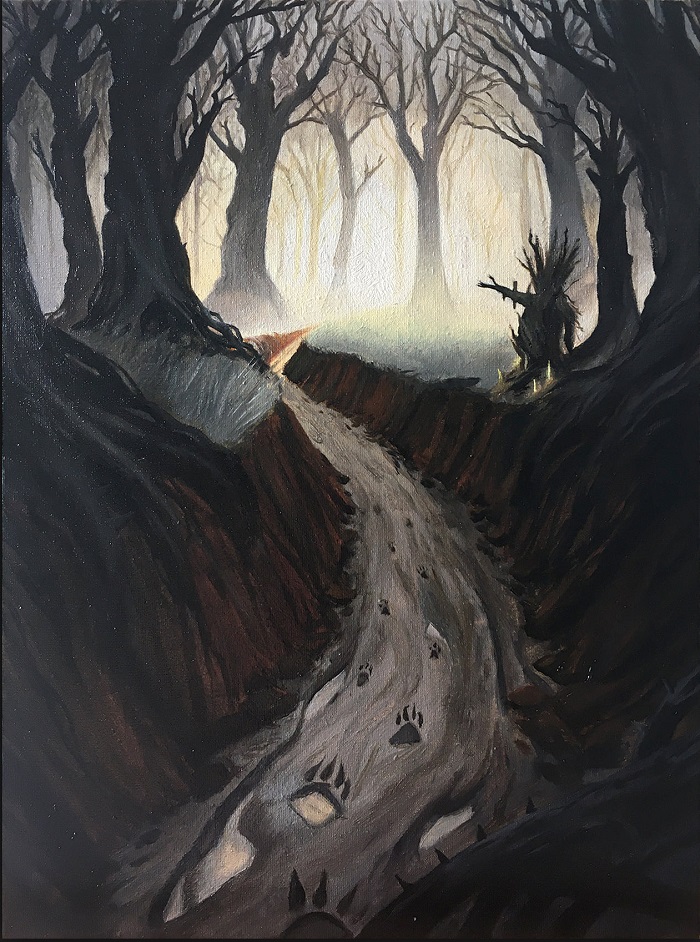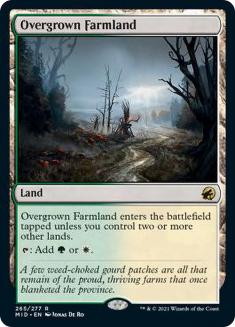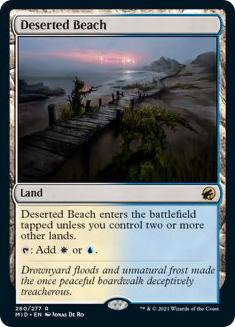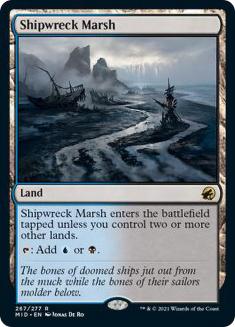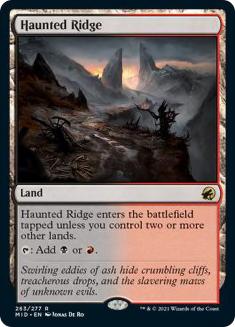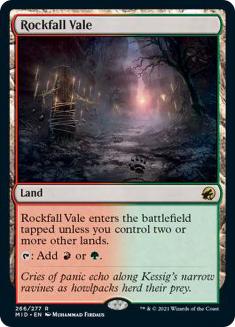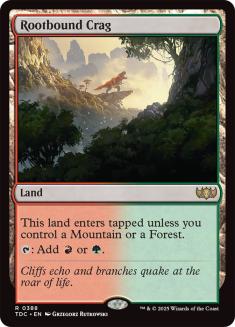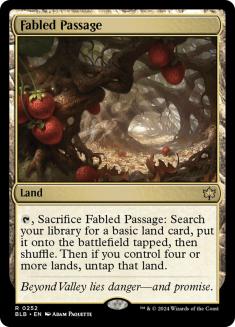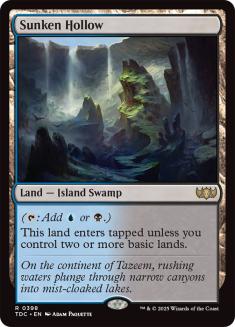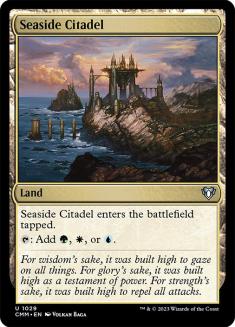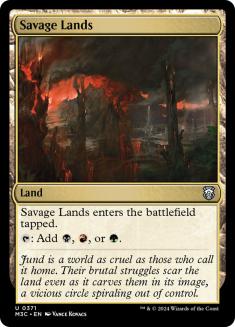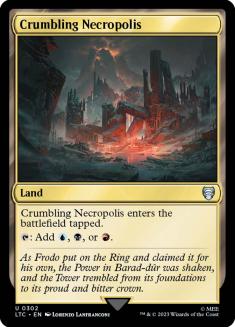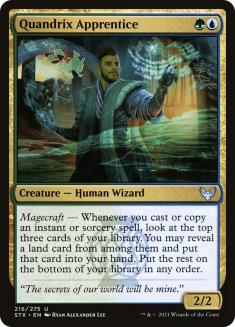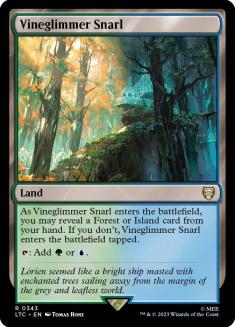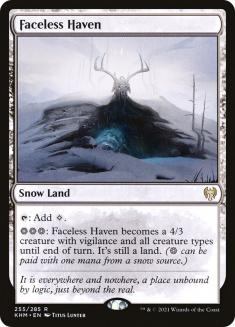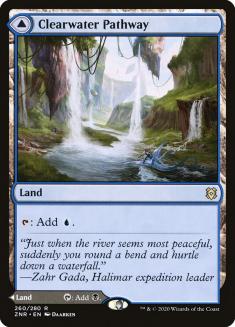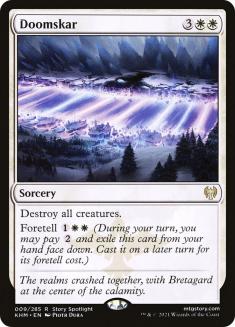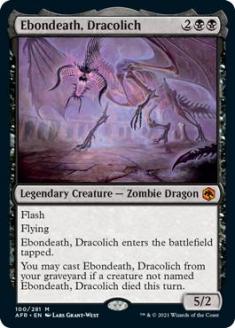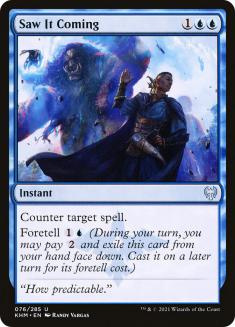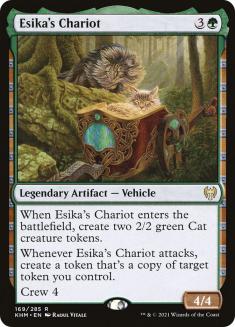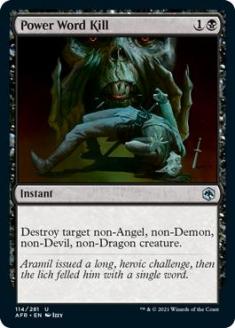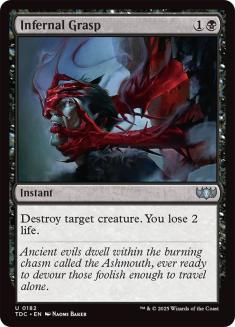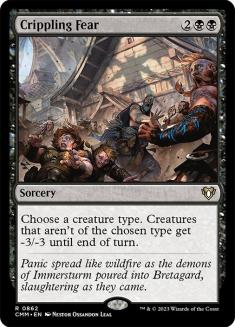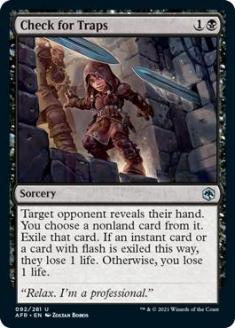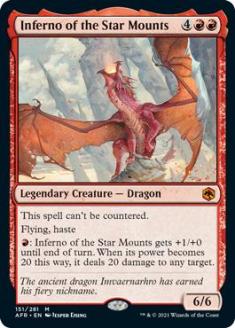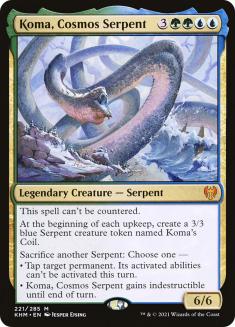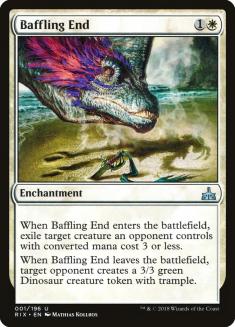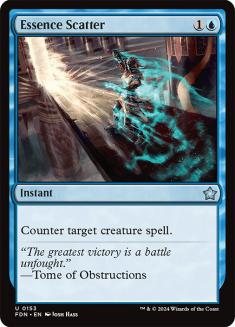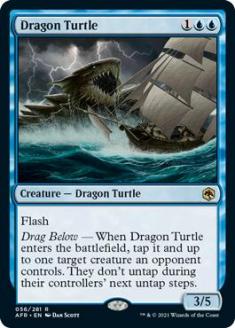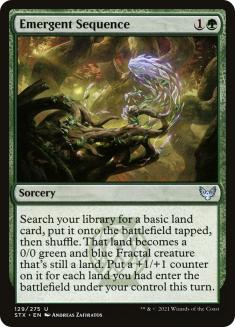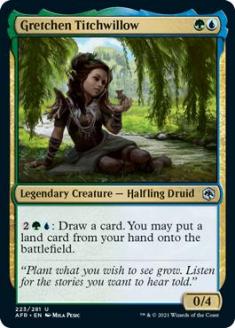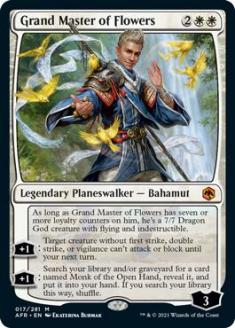Keeping with tradition, the most important cards of Innistrad: Midnight Hunt were the first previews off the bat.
Oh yeah, it’s land talk time again.
While this specific count on the Innistrad: Midnight Hunt slowlands is new, the idea of lands that are only untapped conditional to your other lands is far from it. Our closest points of comparison are the Magic 2010 checklands, Fabled Passage, and the Battle for Zendikar lands.
The immediate takeaway is that all these lands shared one common risk, summarized in this obvious statement: if your hand is all slowlands, you aren’t getting anywhere fast. The key here is “all,” because as soon as you have one other land you have a natural curve of Turn 1 slowland, Turn 2 other land and make a play, Turn 3 good to go. It’s way easier for a slowland to be untapped than it would be for your Fabled Passage land to be, and there’s less time for weird color availability to mess with your early land sequencing too.
The past cap on checklands was around seven copies in a deck, and I expect similar numbers on slowlands. If anything you get a little more margin since if your first three lands are all checklands, you’re still down a mana on Turn 3, while slowlands let you keep pace.
This cap does drop a bit as your land count drops as well, but not in a broadly applicable way. Technically you shouldn’t be playing eight slowlands in a 23-land deck, but you also shouldn’t be playing a 23-land three-color deck most of the time anyway. In a two-color deck this really isn’t a big issue, since the fail case is drawing a two-land hand with exactly two of your four slowlands. That’s some lost percentage, but it’s low enough that having better mana in the rest of your games is a bigger deal.
To summarize all these findings: just play all your on-color dual lands and your mana should be fine. Slowlands plus Pathways create a decent and effortless two-color ore three-color manabase.
That brings us to the next point: we only got five of these slowlands in Innistrad: Midnight Hunt. It’s back to some classic five-set imbalanced mana, and that now means allied colors and “Shard” mana get the boost this time around. The incomplete set also makes it unlikely you’re ever going to exceed the seven- or eight-copy pseudo-max I mentioned previously, but keep it in mind for when this cycle is eventually completed. I guess your four-color deck could go ham on slowlands, but you have 24 Pathways available at that point. You also aren’t absolutely excluded from breaking the mold and going Mardu or something, but you really need that odd color out (white in the Mardu case) to be a slight splash off Pathways.
The entire set of Strixhaven did get extremely shafted in this whole allied-color deal though. Nice enemy-color set, but friends don’t let friends play Snarls.
Slowlands aren’t good in aggressive decks, and this time that statement is so obvious I instantly made a dumb Tweet about it. But that’s fine, because making multicolor aggro mana that won the fight against Faceless Haven was a lost cause. You’re still going to see Mono-Red Aggro over Rakdos or Gruul as long as there are one-drops worth casting.
With slowlands and Pathways, the mana in two-color midrange decks will just work. It mostly just worked in Throne of Eldraine Standard, but the combination of Pathways and Fabled Passage led to you controlling a lot of single-color-producing lands, even if you had a choice of which color those produced. That meant mixing double-color-costed cards across colors was dicey, and now that you have true dual lands that isn’t the case. I’m not suggesting you pair Werewolf Pack Leader and Flameskull, or Lullmage’s Domination and The Book of Exalted Deeds, but if your deck has Skyclave Apparition and Gnarled Professor you aren’t breaking the law. I would caution against doubling up on critical color commitments across three colors, but that’s more a Pathway issue than a slowland one.
The three-color situation with these lands will go more towards the center color of the trio, just because you get that color for free off the slowlands where you have to make a decision to Pathway to your other two colors. For example, let’s say you’re Shaheen Soorani and have to choose a color on your early Hengegate Pathway. Because you just get blue mana whenever you eventually find a Deserted Beach or Shipwreck Marsh, you’ll almost always want to play that on the white side so your Doomskar isn’t stuck in your hand. Instead, you get to cast Doomskar and die happy when they attack with Faceless Haven.
This three-color base opening up is definitely the most interesting place to work on new Standard ideas, so let’s get cracking on that.
My initial search parameters were “what good cards cost double-color to cast,” and immediately Ebondeath, Dracolich jumped out. While it wasn’t quite on par for Throne of Eldraine Standard, it’s a pretty darn good card. If it gets involved in combat, things are going to end well for you, and it matches up decently as interaction for both Goldspan Dragon and Faceless Haven.
Ebondeath holding off Goldspan Dragon comes up once you go down the road of playing planeswalkers, and while the last year has been dicey for that card type, Innistrad: Midnight Hunt brings some of the spark back. Wrenn and Seven seems like a natural fit with Ebondeath since you want the Mulch [+1] to actually get you more than just lands, and even if the Treefolk token has reach, it could use a second blocker against removal. Esika’s Chariot is a pretty obvious additional four-drop, both as another way to apply midrange pressure next to Ebondeath and as a great curve-out into Wrenn and Seven’s copiable token.
Creatures (15)
Planeswalkers (4)
Lands (25)
Spells (16)

Playing good cards is a combo with overloading on lands. You will hit your lands basically every game to cast the good cards, but you also can get away with some sketchy color stuff because this deck has a million lands and fixes mana by just drawing more sources. There are weirdly few spells in this deck, which makes it even weirder that it was hard to fill out. I blame the fact that two of the last four sets are based on sideways synergies over raw card quality (Zendikar Rising and Strixhaven) and another is based on something unknown over raw card quality (Adventure in the Forgotten Realms). I can only assume the next 200 Innistrad: Midnight Hunt cards will help Kaldheim cards build good midrange decks.
Don’t ask me where Power Word Kill is in this deck. Instead ask yourself why a removal spell that doesn’t kill Goldspan Dragon or Faceless Haven is in your deck. Same with Infernal Grasp and putting a removal spell that costs life into your deck.
Having played against Crippling Fear in the late days of Throne of Eldraine Standard, I’m extremely excited about the card’s prospects moving forward. Lotus Cobra into Crippling Fear is something I expect to end aggressive decks, letting the midrange deck keep their mana development while sweeping. I don’t know why Plague Wind costs four mana now, but I’m not going to ask a lot of questions about it.
Uhhh, something is missing from this format. Check for Traps is not a good discard spell and I certainly hope I can cut it from an updated version of this deck in a few days.
I still remain a believer in Inferno of the Star Mounts. It’s a sideboard card for now, but my goal is to end my opponent’s participation in midrange mirrors. This maindeck does enough stuff with card advantage for now. I just want to hit them with a giant Dragon and eject them from the game.
On to a similar card, I did want to explore the white control options. I’ll leave the Espering to Shaheen, but the card that most interested me was Koma, Cosmos Serpent. Again, a lot of my search when it comes to functional mana right now is about using it to let you play raw card quality, and Koma certainly qualifies as that. As Brad Nelson stated today in his article, Arlinn, the Pack’s Hope is a big issue for control, but just like the Jund deck, we can build something that fights Arlinn on its level while stretching up to Koma to put games out of reach.
Creatures (11)
- 1 Tangled Florahedron
- 3 Koma, Cosmos Serpent
- 3 Dragon Turtle
- 2 Gretchen Titchwillow
- 2 Monk of the Open Hand
Planeswalkers (4)
Lands (27)
Spells (18)

As the lack of sideboard kinda implies, there are some serious holes to fill here, but I’m excited by some of the things going on.
The big missing piece is a single good, cheap interactive card. Or really any efficient interaction. You can do some good midrange brawling, but you don’t have a card that lets you position against Goldspan Dragon on the stack or even against a random two-drop.
Dragon Turtle is a pretty underrated card in the resized Standard format, or maybe it’s over rate? I don’t know. 3/5 is just big against Faceless Haven and it does a decent job of halting Goldspan Dragon without producing a Treasure while still being a good cheap card.
The cards I’m trying to fill that low end with are Emergent Sequence and Gretchen Titchwillow. Emergent Sequence should be obvious since Rampant Growth is just a good card, but Gretchen probably gets swept up in anti-hype of being a random Adventures in the Forgotten Realms card. Fortunately I’ve built up a healthy respect for the card both drafting (even if Simic is bad) and playing Modern (even if Amulet Titan is dicey). When you’re just trying to cast a seven-drop and do some interacting, I’m not sure it gets much better than a solid early blocker that also provides ramp and cards later.
Continuing the trend of underrated Adventures in the Forgotten Realms cards, I’m pretty into Grand Master of Flowers. Adding loyalty to generate a body is not something to ignore. Maybe this is just a bad Esika’s Chariot or Wrenn and Seven, but with a white-centric manabase and a desire for some early-drops, I’m willing to give it and the Monks a try.
After a year of weirdly bad mana, I’m excited to just have mana that works again. It’s not shockland + checkland mana like a Ravnica set might have, but it’s getting pretty close. Just let us cast some good cards on time in interesting mixes and the rest of a good format should sort itself out.

